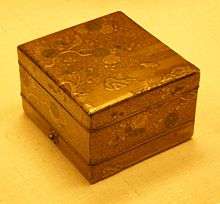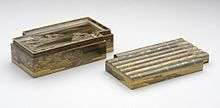Kōbako
A kōbako (香箱) is an incense storage box used in kōdō (香道, "Way of Incense"), the traditional Japanese art which involves using and appreciating incense within a structure of codified conduct. It can be used to store the items needed for the incense-comparing games.[1] called kumikō (組香) and genjikō (源氏香). The similar word kobako (小箱; note the short o rather than long ō in the first syllable) means "small box" in Japanese.



The kōbako is somewhat similar to a kōgō, an incense box used in the Japanese tea ceremony. However, "the kōbako was usually a little larger than the kōgō, and sometimes had a small tray or small boxes to go with it."[2]
Often decorated with lacquer and showing a high degree of craftmanship, kōbako are studied and collected by those who appreciate Japanese arts and crafts.[3][4][5][6]
Related meanings
The rugged Sōunkyō Gorge in Japan's Daisetsuzan National Park has an area of "fantastic crags".[7] "The narrowest section of the gorge is called Kobako, or "Small Box", because of the enclosed feeling imparted by the towering rock pillars shooting up from the riverbanks." [8]
In 1936, Bourjois introduced a perfume called Kobako, which was packaged in a container "inspired by an old lacquered cabinet".[9] The perfume, described as a "Chypre Floral fragrance", is still on the market.[10]
According to Kunihiko Kasahara, there is a traditional origami pattern called a Tsuno Kobako, which is identified as a "folded pouch for perfume". This paper folding pattern goes back at least to 1734, when it appeared in a book called Ranma Zushiki.[11]
Kōbako is a slang term for "vagina" in Japanese. It is among several such slang terms for the vagina that "have flourished since the Edo period, and have been sharpened by centuries of persistent use".[12]
References
- Dick, Stewart (1905). Arts and crafts of old Japan. A.C. McClurg & Co. p. 131.
- Bincsik, Monika (2006). "Kōgō and Kōbako as "Objets de Vitrine" in Europe during the Second Half of the 19th Century". Arts of Asia. Hong Kong: Arts of Asia. 36.
- Bushell, Raymond (1979). The inrō handbook: studies of netsuke, inrō, and lacquer. Weatherhill.
- Stern, Harold P. (1972). The magnificent three: lacquer, netsuke, and tsuba: selections from the Collection of Charles A. Greenfield. New York, New York: Japan Society.
- Okada, Barbra Teri (1983). A sprinkling of gold: the lacquer box collection of Elaine Ehrenkranz. Newark, New Jersey: Newark Museum. p. 134.
- Tachau, Hannah (June 1914). "The Collector's Scrap Book: Old Lacquer". House Beautiful. New York, New York. p. 94. Retrieved June 15, 2011.
- "Soun-kyo Gorge". Japan National Tourism Organization.
- Dodd, Jan; Richmond, Simon (2001). The rough guide to Japan. London: Rough Guides. p. 353. ISBN 978-1-85828-699-0.
- "Crystal". Arts & Decoration, Volume 45. Adam Bunge. 1937.
- "Kobako Bourjois for women". Fragrantica Perfume Encyclopedia. Fragrantica. 2006–2011. Retrieved June 15, 2011.
- Kasahara, Kunihiko (2005). The Art and Wonder of Origami. Bloomington, Indiana: Quarry Books. pp. 50–56. ISBN 978-1-59253-213-1.
- Constantine, Peter (1994). Japanese Slang: Uncensored. Clarendon, Vermont: Tuttle Publishing. p. 94. ISBN 978-4-900737-03-7.